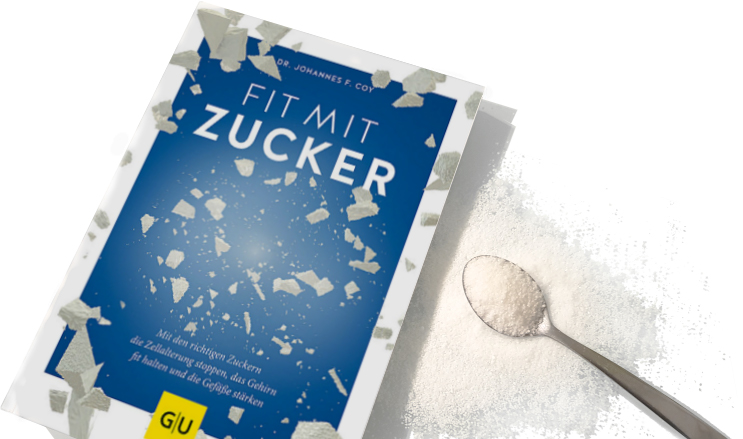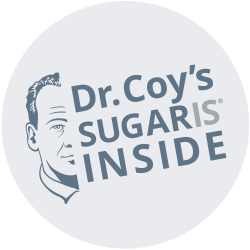Learn more about Dr. Coy and the creation of his sugar solutions.
Dr Johannes Coy is a world-renowned scientist whose research focuses on the health benefits of sugar awareness. Dr Coy has made a number of important genetic discoveries which change our understanding of cancer and nutrition and make him the leading expert on sugars.

Book: Fit with Sugar, by Dr Johannes Coy
Dr Coy has written several books about cancer nutrition. His latest book, Fit with Sugar, is now available. In this book, you’ll discover the evolutionary role of sugar in the human body. Consuming too much conventional sugar isn’t good for our health, but with the right sugars, we can stop cell ageing, keep the brain fit, protect against diseases and switch on fat burning. Find out how you can maintain physical and mental performance using natural low- glycaemic sugars and sugar substitutes. The book includes many delicious recipes for cakes, snacks and desserts, so you can implement a sugar-conscious diet easily and intelligently, without giving up sweet treats.
Buy the book: Cancer-Fighting Diet: Diet and Nutrition Strategies to Help Weaken Cancer Cells and Improve Treatment, by Dr Johannes Coy.
Research & Resources
The influence of D-ribose ingestion and fitness level on performance and recovery.
Skeletal muscle adenosine triphosphate (ATP) levels are severely depleted during and following prolonged high intensity exercise. this study was designed to determine what influence D-ribose might have on muscular performance, recovery, and metabolism during and following a multi-day exercise regimen.
The influence of a 12% carbohydrate-electrolyte beverage on self-paced soccer-specific exercise performance
This study investigated the effects of consuming a 12% carbohydrate-electrolyte beverage during simulated soccer match-play. The beverage improved self-paced exercise performance and dribbling speed compared to water and placebo. Blood glucose levels were higher with the carbohydrate-electrolyte beverage, but it did not attenuate post-exercise cognitive decline. Overall, the findings suggest that the beverage can enhance soccer performance.
Remodelling of Oxidative Energy Metabolism by Galactose Improves Glucose Handling and Metabolic Switching in Human Skeletal Muscle Cells
This study explored how switching the energy source from glucose to galactose in cultured muscle cells (myotubes) affects their metabolism. Cells grown with galactose showed improved ability to burn fatty acids and glucose, as well as increased mitochondrial function and content. They also handled glucose better and were more flexible in switching between using fats and glucose for energy. This suggests that galactose helps boost oxidative metabolism and could be a useful model for studying conditions like insulin resistance and mitochondrial disorders.
D-tagatose protects against oleic acid-induced acute respiratory distress syndrome in rats by activating PTEN/PI3K/AKT pathway
This study investigates the potential benefits of D-tagatose (TAG), a low-calorie sugar, in treating acute respiratory distress syndrome (ARDS), a condition marked by lung inflammation and fluid buildup. Using an oleic acid-induced ARDS rat model, researchers found that TAG significantly protected lung tissues. In the experiment, rats were divided into three groups: a control group, an ARDS group, and a TAG-treated ARDS group. TAG treatment, administered three days before inducing ARDS, improved oxygen levels, reduced respiratory acidosis, and decreased inflammation. Additionally, TAG improved lung vascular permeability and supported the maintenance of lung structure by promoting the differentiation of alveolar cells. These benefits are thought to be mediated through the PTEN/PI3K/AKT pathway, suggesting TAG as a potential new treatment for ARDS.
Ingesting isomaltulose versus fructose-maltodextrin during prolonged moderate-heavy exercise increases fat oxidation but impairs gastrointestinal comfort and cycling performance
This study examined the metabolic and performance effects of ingesting isomaltulose, a slowly absorbed carbohydrate, during exercise. The results showed that isomaltulose increased plasma nonesterified fatty acid concentration and fat oxidation while decreasing carbohydrate oxidation compared to fructose-maltodextrin supplementation. However, isomaltulose ingestion led to severe gastrointestinal symptoms and negatively affected exercise performance. These findings suggest that isomaltulose may not be suitable for prolonged or high-intensity exercise compared to other carbohydrate supplements.
Galactose increases mitochondrial activity which induces fat mobilisation and fat burning
This study focused on the role of transketolase (TKT) in colorectal cancer. The researchers found that TKT expression was significantly increased in colorectal cancer and correlated with poor prognosis. TKT was found to promote cancer cell growth and metastasis by interacting with GRP78 and enhancing glycolysis through AKT phosphorylation. These findings suggest that TKT could serve as a prognostic indicator for colorectal cancer and potentially be targeted for the development of new treatment strategies.
Substrate Utilization and Cycling Performance Following Palatinose™ Ingestion: A Randomized, Double-Blind, Controlled Trial
This study compared the effects of isomaltulose (PSE) and maltodextrin (MDX) ingestion on endurance exercise performance. PSE resulted in improved time trial performance, higher fat oxidation, and a more stable blood glucose profile compared to MDX. PSE may enhance endurance by promoting fat utilization and preserving glycogen.
Exogenous Oxidation of Isomaltulose Is Lower than That of Sucrose during Exercise in Men
This study compared the effects of orally ingested isomaltulose (ISO) and sucrose (SUC) during moderate intensity exercise. ISO showed lower exogenous carbohydrate oxidation rates and higher fat oxidation compared to SUC. Total endogenous carbohydrate oxidation was lower in the SUC trial. ISO had a lower plasma insulin response and a slower rate of digestion compared to SUC. These findings suggest that ISO may promote higher fat utilization and lower reliance on exogenous carbohydrates during exercise.
Low vs. high glycemic index carbohydrate gel ingestion during simulated 64-km cycling time trial performance
This study investigated the effects of low and high glycemic index (GI) carbohydrate feedings during a simulated 64-km cycling time trial (TT). The results showed no significant differences in the overall time to complete the TT between the low GI (honey) and high GI (dextrose) carbohydrate conditions. However, when collapsed, the carbohydrate conditions were faster compared to the placebo condition. Analysis of wattage generated during the last 16 km of the TT showed significant improvements in both the dextrose and honey treatments compared to preceding segments. These findings suggest that carbohydrate supplementation, regardless of GI, may enhance performance during the later stages of a long-distance cycling time trial.
Glycemic index in sport nutrition
The glycemic index (GI) classification of carbohydrates has gained attention in sports nutrition for its potential to impact blood glucose and insulin responses, glycogen recovery, exercise metabolism, and lipid oxidation. While there is biochemical evidence supporting the effects of GI manipulation on adipocyte lipolysis and lipid and carbohydrate oxidation rates during exercise, the functional outcomes have been inconsistent. Some studies have shown improved exercise performance with GI manipulation, but many others have not. This article reviews the effects and limitations of GI manipulation in sports nutrition and proposes a comprehensive strategy for its application.
American College of Sports Medicine Joint Position Statement. Nutrition and Athletic Performance
The Academy of Nutrition and Dietetics, Dietitians of Canada, and the American College of Sports Medicine state that nutrition plays a crucial role in enhancing sports performance and recovery. These organizations provide guidelines on the appropriate type, amount, and timing of food, fluids, and supplements for optimal health and performance in various training and competitive sport scenarios. This position paper serves as a reference for members of these organizations, professional associations, government agencies, industry, and the public. It emphasizes the importance of personalized nutrition plans developed by registered dietitian/nutritionists, particularly those who are Certified Specialists in Sports Dietetics (CSSD), who are experts in sports nutrition.
Novel findings on the metabolic effects of the low glycaemic carbohydrate isomaltulose (Palatinose)
This study included three human intervention trials to investigate the physiological characteristics of isomaltulose (iso). The results showed that iso is effectively absorbed from the small intestine, regardless of the food matrix, and provides a prolonged delivery of blood glucose. It was found to have lower postprandial blood glucose and insulin responses compared to sucrose. Regular consumption of iso within a Western-type diet was well tolerated and did not affect blood lipids in individuals with hyperlipidemia. Although no significant differences were observed compared to sucrose after the 4-week intervention, iso shows promise as a carbohydrate option for individuals at risk of vascular diseases.
Single Ingestion of Trehalose Enhances Prolonged Exercise Performance by Effective Use of Glucose and Lipid in Healthy Men
In a study with 12 healthy men, the effect of trehalose on prolonged exercise performance was investigated. Participants ingested 8% trehalose, 8% glucose, or water in three separate trials. The ingestion of trehalose resulted in lower adrenaline levels compared to water and glucose during later stages of exercise, indicating better preservation of carbohydrates. These findings suggest that a single intake of trehalose can contribute to maintaining exercise performance over a longer period.
Influence of Trehalose Mouth Rinse on Anaerobic and Aerobic Exercise Performance
Trehalose, a slow-absorbing disaccharide with a low glycemic index, has gained attention in sports nutrition. Limited studies have explored its impact on exercise performance. While pre-exercise ingestion of trehalose did not improve time trial performance, it showed potential in enhancing aerobic and anaerobic performance within 30 minutes of ingestion. Exogenous carbohydrate, including trehalose, may not directly contribute to performance but could have an effect through mechanisms like the mouth rinse effect. A study with collegiate runners used a randomized crossover design to investigate the performance-enhancing effects of trehalose, maltose, and an artificial sweetener through mouth rinsing. The concentrations of these substances were chosen to produce similar sweetness.
Effects of a Single Ingestion of Trehalose during Prolonged Exercise
This scientific article investigates the effects of trehalose (TRE) on exercise performance and energy metabolism. Trehalose is a disaccharide that slowly raises blood glucose levels and reduces insulin secretion. The study involved two parts:
- Exercise Performance: The researchers conducted exercise tests using the Wingate test and a 30-minute constant load exercise. Healthy male college students participated in three trials: water (placebo), glucose (GLU), and trehalose (TRE). The results showed that TRE ingestion significantly increased both average and maximum power values during exercise compared to the other groups (p < 0.01).
- Energy Metabolism: After ingesting TRE, the study measured respiratory exchange ratio (RER) and estimated lipid oxidation during 60 minutes of exercise at 40% VO2peak. The findings indicated that TRE ingestion resulted in significantly higher lipid utilization compared to GLU, suggesting that TRE is more effective in utilizing both glucose and lipids for energy during exercise (p < 0.01).
In summary, the study provides new insights into the positive effects of a single TRE ingestion on prolonged exercise performance by efficiently utilizing glucose and lipids for energy.
Preexercise galactose and glucose ingestion on fuel use during exercise
This study looked at how consuming two different types of sugar, galactose (Gal) and glucose (Glu), 30 minutes before exercise affects the use of these sugars during exercise. They had trained male cyclists do three cycling sessions after fasting overnight, and they consumed either a placebo, Gal, or Glu drink before each session.
The study found that Glu increased the use of the sugar from the drink during the first hour of exercise, while Gal was more effective during the last hour. Glu also led to higher glucose levels in the blood and the liver during exercise. However, there were no significant differences in overall carbohydrate or fat use between the two sugar types.
In summary, consuming Glu before exercise provides a quick source of energy in the early stages of exercise, while Gal becomes the primary source of fuel in the later stages, reducing the reliance on liver glucose.
Oxidation of independent and combined ingested galactose and glucose during exercise
This study investigated the impact of consuming a mixture of glucose and galactose during exercise on the utilization of ingested galactose. Fourteen trained male and female participants engaged in 150 minutes of cycling exercise at 50% peak power while ingesting different carbohydrate beverages. They consumed either galactose (GAL), glucose (GLU), or a combination of both (GAL + GLU) in a 1:1 ratio. The study used isotope labelling to measure the oxidation of the carbohydrates.
The study found that when participants consumed GAL + GLU, the concentration of galactose in their blood was lower compared to when they consumed GAL alone. However, combining galactose with glucose did not enhance the oxidation of ingested galactose during exercise. The total oxidation of the combined galactose-glucose blend (COMBINE) was similar to that of glucose alone, suggesting that these blends are a valid alternative to glucose as an energy source during exercise.
In summary, combining glucose and galactose did not enhance the use of ingested galactose during exercise. Galactose-glucose blends can serve as a viable carbohydrate source for energy during exercise, offering similar benefits to pure glucose.
Trehalose alleviates oxidative stress-mediated liver injury and Mallor-Denk body formation via activating autophagy in mice
Trehalose, a disaccharide, has been shown to induce autophagy and reduce cellular stress in various disease models. However, its effects in hepatocytes have not been fully investigated. In a study using mice treated with 3,5-diethoxycarbonyl-1,4-dihydrocollidine (DDC), trehalose was found to induce autophagy, reduce endoplasmic reticulum stress, oxidative stress, Mallory-Denk body formation, and apoptosis in hepatocytes. Electron microscopy revealed the formation of autolysosomes in close proximity to the Mallory-Denk bodies. These findings suggest that trehalose has the potential to be a therapeutic agent for liver diseases associated with oxidative stress by activating autophagy.
Trehalose alleviates oxidative stress-mediated liver injury and Mallor-Denk body formation via activating autophagy in mice
This study investigated the effects of trehalose on autophagy, ER stress, oxidative stress-mediated cytotoxicity, and Mallory-Denk body (MDB) formation in hepatocytes. The study used a mice model with 3,5-diethoxycarbonyl-1,4-dihydrocollidine (DDC) treatment and administered trehalose through intraperitoneal injection. The results showed that trehalose induced autophagy, reduced ER stress, oxidative stress, MDB formation, and apoptosis in hepatocytes. Electron microscopy revealed autolysosome formation close to the MDBs. These findings suggest that trehalose has the potential to be a therapeutic agent for oxidative stress-related liver diseases by activating autophagy.
Get in touch with Intelligent Sugar
Got a question about Dr Coy’s sugars? Contact info@intelligentsugar.info
If you have a question about a specific health condition, please speak to your doctor.

